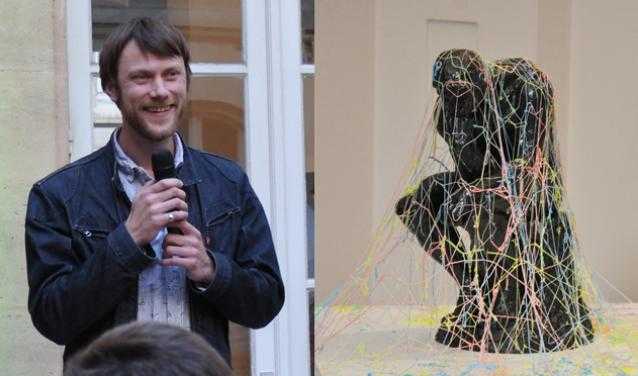Home>2015 Sciences Po Prize for Contemporary Art

28.04.2015
2015 Sciences Po Prize for Contemporary Art
An interview with Mathieu Roquigny (photo), who won the Audience Award in the sixth annual Sciences Po Prize for Contemporary Art on Tuesday 22 April 2015. Each year the competition honours young artists living and working in France. It is a highlight in Sciences Po’s cultural year.
- Why did you chose to enter Think about Party (photo) in the Sciences Po Prize for Contemporary Art?
I chose this work after a conversation with the organisers. It speaks to everyone and could really resonate in an exhibition space such as Sciences Po. At first glance it is a reimagining of a very famous statue, the original of which is only a few streets away from Sciences Po in the gardens of the Musée Rodin in Paris. When you look again it’s a commentary on student life which is shown to be fun but fleeting through the use of the silly string. What interests me is the contrast between this futile and ephemeral aspect of the silly string and the massive hand-sculpted statue of The Thinker, and how this relates to Sciences Po more generally. I love to hijack everyday materials and objects which aren’t normally associated with art and I take these normal materials and combine them with a piece of art that everyone knows which perhaps makes my work more accessible. So it’s therefore a real honour to be recognised with the Audience Award!
- What does recieving this award mean to you? What interests you about this competition being organised by students?
It really is a great pleasure for me because young people are a key audience. I find it interesting to build bridges between worlds that don’t normally meet, just like how Sciences Po created a dual degree with the École du Louvre for example. I am proud to be part of this growing trend. It actually resonates perfectly with my artistic approach as I try to create works that are first made accessible through humour but can then lead to more serious thoughts. There are many ways to interpret a piece like Think about Party. Beyond it being an irreverent parody, the viewer is also invited to be drawn to other conclusions which then pose yet more questions.
Related link
Culture, sports and associations at Sciences Po